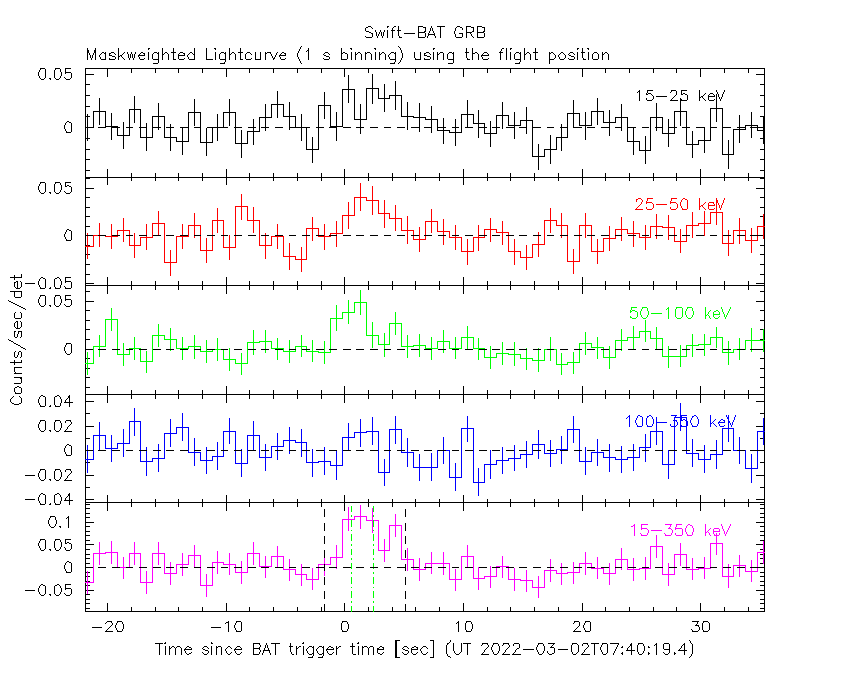
E. Troja (NASA/GSFC/UMCP), M. Perri (SSDC and INAF-OAR) and M.H. Siegel (PSU) for the Swift team
At 07:40:19 UT, the Swift Burst Alert Telescope (BAT) triggered and located GRB 220302A (trigger=1094950) (Troja et al. GCN Circ. 31661). Swift did not slew to the burst. At the time of the trigger, the initial BAT position was 67° from the Sun (2.8 hours West) and 72° from the 0%-illuminated Moon. Table 1 contains the best reported positions from Swift, and the latest XRT position can be viewed at http://www.swift.ac.uk/xrt_positions.
Table 2 is a summary of GCN Circulars about this GRB from observatories other than Swift.
Standard analysis products for this burst are available at https://gcn.gsfc.nasa.gov/swift_gnd_ana.html.
BAT refined results are not available.
Analysis of the initial XRT data was reported by Perri et al. (GCN Circ. 31673). We have analysed 7.7 ks of XRT data for GRB 220302A, from 32.5 ks to 241.1 ks after the BAT trigger. The data are entirely in Photon Counting (PC) mode. The enhanced XRT position for this burst was given by Osborne et al. (GCN Circ. 31666).
The light curve (Figure 2) can be modelled with a power-law decay with a decay index of α=0.7 ± 0.3.
The results of the XRT team automatic analysis are available at http://www.swift.ac.uk/xrt_products/01094950.
The Swift/UVOT began settled observations of the field of GRB 220302A 32464 s after the BAT trigger
(Siegel and Troja GCN Circ. 31682).
No optical afterglow consistent with the XRT position (Osborne et al. GCN Circ. 31666) is detected in the initial UVOT exposures.
Table 3 gives preliminary
magnitudes using the UVOT photometric system
(Breeveld et al. 2011, AIP Conf. Proc., 1358, 373).
No correction has been made for the expected extinction in the Milky Way
corresponding to a reddening of

Figure 1. The BAT
mask-weighted light curve in the four individual and total
energy bands. The units are counts

Figure 2. The XRT light curve.
Any data from a crosshatched region are not included in the fit.
| RA (J2000) | Dec (J2000) | Error | Note | Reference |
|---|---|---|---|---|
| 2 |
+49°23'13.1" | 2.9" | XRT-final | UKSSDC |
| 2 |
+49°23'13.1" | 2.9" | XRT-enhanced | Osborne et al. GCN Circ. 31666 |
| 2 |
+49°23'20" | 3' | BAT-initial | Troja et al. GCN Circ. 31661 |
| Band | Authors | GCN Circ. | Subject | Observatory | Notes |
|---|---|---|---|---|---|
| Optical | Lipunov et al. | 31662 | Swift GRB 220302A: Global MASTER-Net observations report |
MASTER | |
| Optical | Hu et al. | 31669 | BOOTES-5/JGT optical upper limit | BOOTES | upper limits |
| Filter | Exp(s) | Mag | ||
|---|---|---|---|---|
| whit |
32464 | 32614 | 147 | >19.9 |
| white | 32464 | 32614 | 147 | >19.9 |
| v | 32621 | 33528 | 885 | >19.2 |
| m2 | 33533 | 34194 | 651 | >19.7 |
Table 3. UVOT observations reported by Siegel and Troja (GCN Circ. 31682). The start and stop times of the exposures are given in seconds since the BAT trigger. The preliminary 3-σ upper limits are given. No correction has been made for extinction in the Milky Way.
March 5, 2022